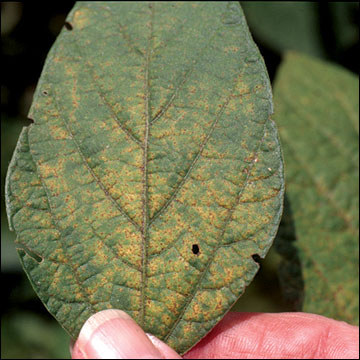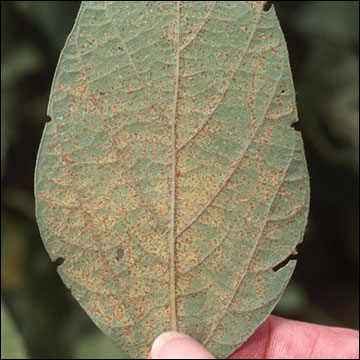Soybean rust
Phakopsora pachyrhizi
 Upper leaf surface
Upper leaf surface
 Lower leaf surface
Lower leaf surface
Upper leaf surface symptoms
Symptoms of soybean rust begin on the lower leaves of the plant as small lesions that may range from light green to yellow to brown flecks on the upper leaf surface. As the disease develops the lesions become more distinct and lesions may merge, killing larger areas of leaf tissue.
Lower leaf surface symptoms
On the lower leaf surface the lesions may range from gray to tan or reddish brown in color. When mature the lesions on the lower leaf surface consist of small pustules surrounded by slightly discolored tissue. Each pustule has a circular pore or opening through which the masses of tan spores are released. The pustules and spores may be visible on the lower leaf surface if a 10x or 20x hand lens is used to examine the leaf.
Canopy symptoms
Soybean rust tends to start in the lower part of the canopy and can move up through the plant quickly if weather conditions are favorable for disease development.
Weather
Temperatures in the range of 46 to 82 degrees Fahrenheit, high relative humidity and prolonged periods of leaf wetness favor the development of soybean rust. Spores are easily spread by wind over both short and long distances.
Survival
The soybean rust pathogen does not survive on infested residues left in the field and is not seedborne. Infection is the result of inoculum produced on living host plants or spores blown into a production area.
Distribution in Missouri
Before Nov. 10, 2004, soybean rust had not been reported in the continental United States. The detection of soybean rust in Louisiana was confirmed on Nov. 10, and the disease was subsequently found in the Gulf states of Mississippi, Alabama, and Florida and north to Georgia, South Carolina, Tennessee, Arkansas and Missouri.